Rules: UGM Rector Decree on Technical Guidelines for UGM Building Code Page 40-45
The University has regulated the water and waste management system into several articles.
- Article 11.1 Clean Water Management System


The regulations have recently been amended in the Rector Decree on Technical Guidelines for UGM Building Code concerning Clean Water Management System. Article 11 Verse 1 states that “In general, it follows the provisions stipulated in SNI. Each cluster/group of buildings is required to provide water storage in the form of a ground tank with a capacity as needed, then pumped to the upper tank for distribution”.
- Article 11.2 Drinking Water Management System


The regulations have recently been amended in the Rector Decree on Technical Guidelines for UGM Building Code concerning Drinking Water Management System. Article 11 Verse 2 states that “Each building must provide a separate drinking water installation with clean water installations to be integrated with the campus Water Supply System (SPAM). Drinking Water Supply System (SPAM) on campus, there needs to be a special ground water tank (GWT) for drinking water. drinking water”.
- Article 11.3 Waste Water Management System

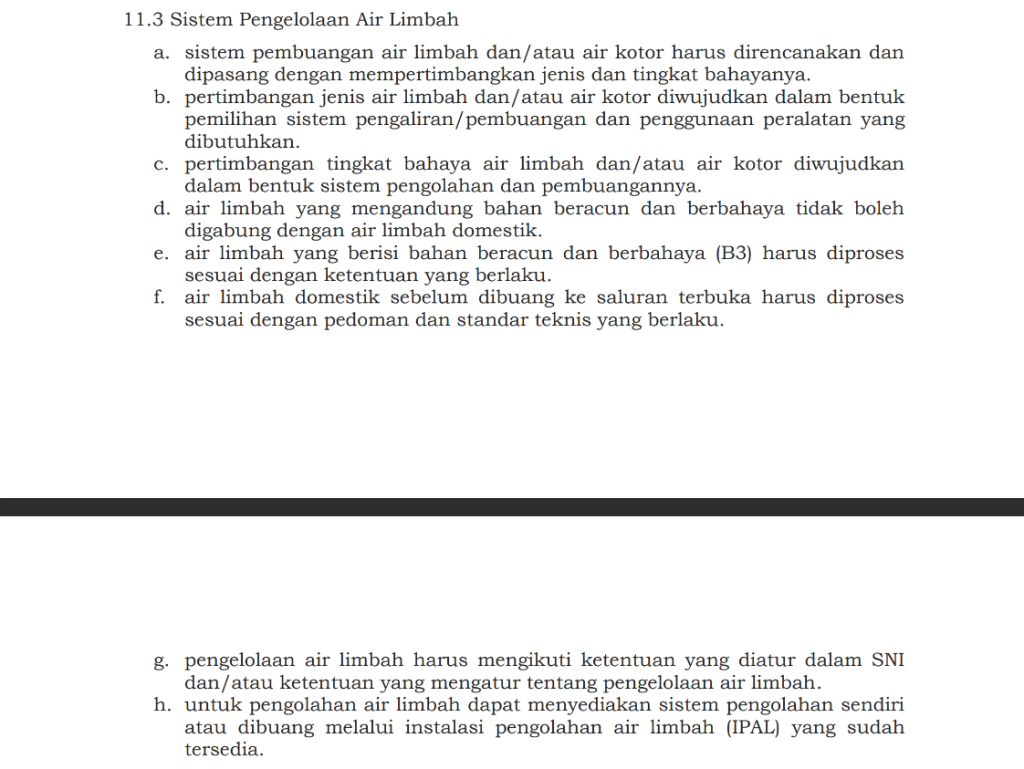
The regulations have recently been amended in the Rector Decree on Technical Guidelines for UGM Building Code concerning Wastewater Management System. Article 11 Verse 3 states several points. Wastewater and foul water disposal systems must be carefully planned and installed based on the type and level of hazard. The type of wastewater determines the selection of the disposal system and necessary equipment, while the hazard level dictates the treatment and disposal methods. Toxic and hazardous wastewater must be processed separately from domestic wastewater and in accordance with regulations. Domestic wastewater must be treated before discharge, following technical guidelines and standards. Wastewater management should comply with SNI and other relevant regulations, and treatment can be done either on-site or through an existing wastewater treatment plant.
- Article 11.4 Rainwater Management System

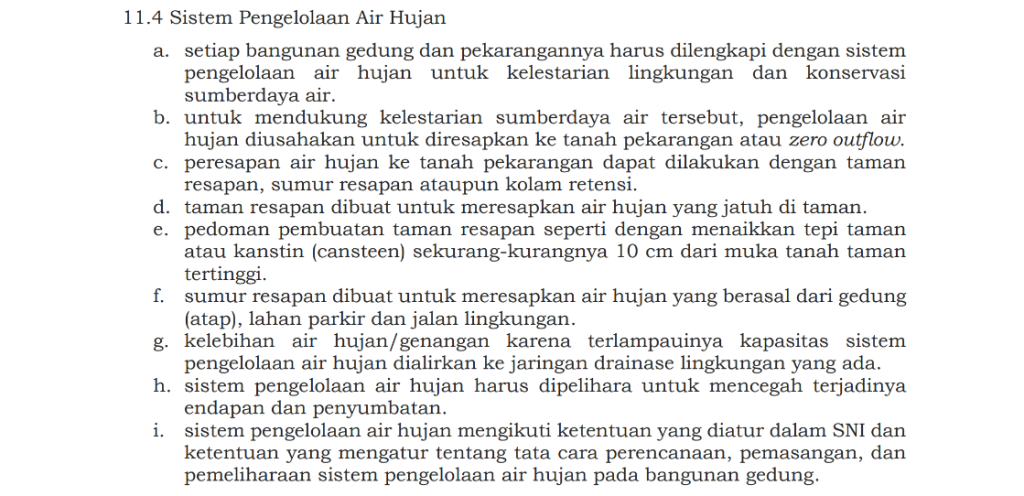
The regulations have recently been amended in the Rector Decree on Technical Guidelines for UGM Building Code concerning Rainwater Management System. Article 11 Verse 4 states several points. Every building and its surrounding area must have a rainwater management system to support environmental sustainability and water resource conservation. Rainwater should be absorbed into the ground or achieve zero outflow, using methods like infiltration gardens, soak wells, or retention ponds. These systems must be maintained to prevent sedimentation and blockages, and they should comply with SNI and other relevant regulations.
- Article 13.2 Technical Planning Stage Requirements – Green Building Requirements Water use efficiency (13.2.3; 13.2.7)



The regulations have recently been amended in the Rector Decree on Technical Guidelines for UGM Building Code concerning Technical Planning Stage Requirements – Green Building Requirements Water use efficiency. Article 13 Verse 2 states that green building technical planning stage requirements consist of site management, energy use efficiency, water use efficiency, indoor air quality, use of environmentally friendly materials, waste management and wastewater management.
Article 13 Verse 2 Section 3 concerning Water Use Efficiency addresses; water source, water usage, and use of water-saving sanitary appliances (water fixtures). Article 13 Verse 2 Section 7 concerning Wastewater Management includes: a. providing facilities for the treatment of solid and liquid waste before disposal into the city sewer system, and b. recycling water from liquid waste (grey water).
Rules: UGM Rector Decree on UGM Campus Transportation Masterplan Guidelines
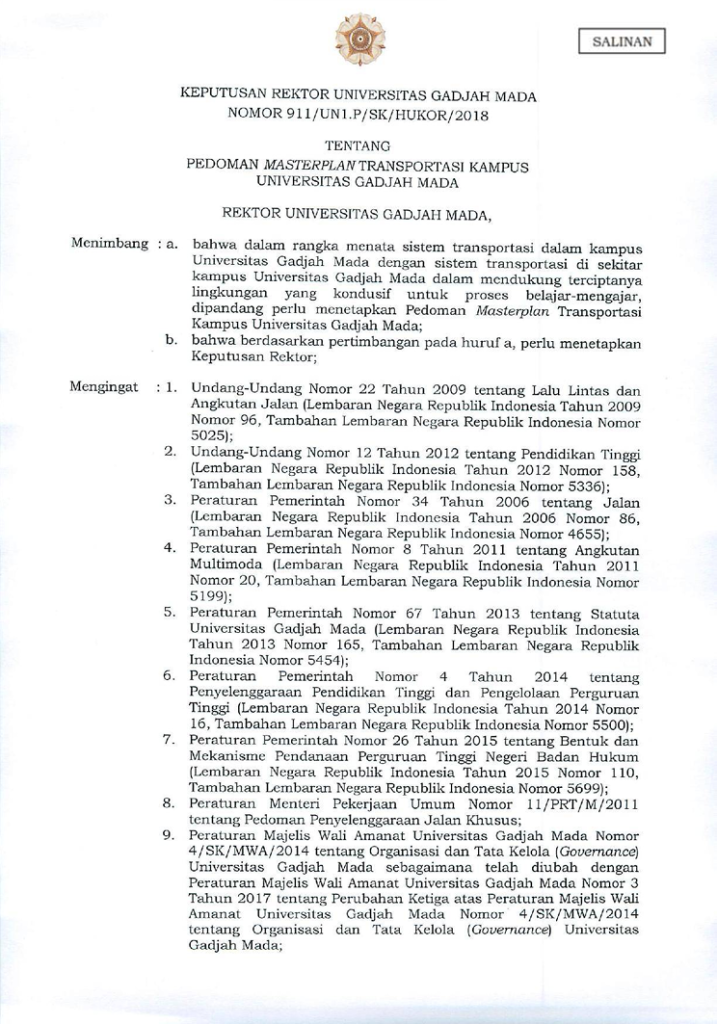
Since 2018, the University has arranged the transportation masterplan guidelines. It is supported towards zero emissions, a one-gate campus, and a better campus network due to developing a campus atmosphere for pedestrians and cyclists.
Electricity and Water Guidebook
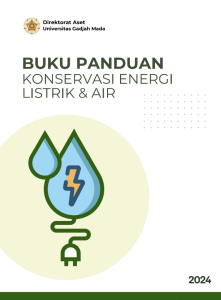
The electricity and water guidebook uses the standard by UI Metric Guideline as one of the references. The technical guidelines are checked as the performance indicator for the use of electricity and water in each building.
Implementation of water-conscious building standard at UGM - EDGE Certification
- Agrotropic Learning Center (AGLC)

Agrotropica Learning Center (AGLC) is one of the facilities in the Faculty of Agriculture. Sustainability features include reduced window to wall ratio, a rainwater harvesting system, daylight sensors, efficient fixtures and more. The Agrotropica Learning Center UGM has received Final EDGE Certification from the Green Building Council Indonesia. The AGLC has successfully reached water savings of 38% in total.
- Animal Science Learning Center (ASLC)

The Animal Science Learning Center (ASLC) is a strategic academic facility of the Faculty of Animal Science. The 6,030 square meter five-story building accommodates specific rooms including discussion rooms, research dissemination rooms, reference rooms, co-working spaces, and integrated laboratories. The Animal Science Learning Center (UGM) has received EDGE Advanced Certification from the Green Building Council of Indonesia. The ASLC has successfully reached water savings of 40% in total.
- Integrated Forest Farming Learning Center (IFFLC)

The Integrated Forest Farming Learning Centre (IFFLC) is one of the buildings located in the Faculty of Forestry. The IFFLC focuses on research and education to develop the Integrated Forest Farming System (IFFS), which integrates different fields of farming systems, including agriculture, veterinary, husbandry, and forestry. This EDGE Advanced building has technologies such as photoelectric sensors for lighting, LED bulbs, water-efficient fixtures, and a rainwater harvesting system. The university has successfully reached water savings of 43% in total.
- Law Learning Center (LLC) UGM

The Law Learning Center (LLC) is part of the Faculty of Law compound at Gadjah Mada University. It utilizes resource-efficient design features and technologies to reduce its environmental impact and save on operating costs. LED lighting, reflective paint, and solar photovoltaics reduce the building’s energy use, while water-efficient plumbing fixtures and a grey water treatment and recycling system reduce the building’s water use.
The LLC was built with funds from the Japan International Cooperation Agency’s (JICA) loan for the expansion of Gadjah Mada University’s academic offerings and the sustainable development of its facilities. The LLC has successfully reached water savings of 37% in total.
- Faculty of Biology – Building B

The new Faculty of Biology Building B has green features that conserve natural resources and leave a lower carbon footprint—designed and constructed by PT. Omega Minerba Gan, the Faculty of Biology Building, lowers operational costs with the help of external shading devices, single-flush water closets and clay-tiled roofing. The building’s green features have been implemented at no additional cost to the university, resulting in a positive sum gain when utility bills are considered. The building B has successfully reached water savings of 30% in total.
Implementation of water-conscious building standard at UGM - GBCI Certification
- Faculty of Biology – Building B
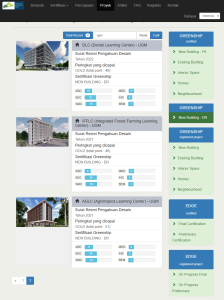
8 buildings (SGLC, ERIC, FRC, APSLC, TILC, DLC, IFFLC, AGLC) at UGM are in the process of GBCI certification, and one building (ASLC) has been GBCI certified. Water conservation (WAC) criteria have been implemented in UGM buildings for the certification. The nine buildings have been tested to implement water use efficiency in design and implementation.
References:
Rules
- Rector’s Decree Number 157/UN1.P/KPT/HUKOR/2020 (Article 11.1-13.2)
- Rector’s Degree about Campus Transportation Masterplan Guidelines
- The electricity and water guidebook
EDGE Certification
